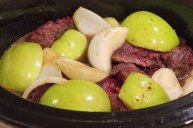When I was young, my dad hunted to fill our freezer and feed our family of six. Growing up on venison, I tend to prefer it over any other type of meat. I actually don't recall even eating beef in my younger years. Today, my husband's family raises cattle, so our freezer is a mix of wild game and, of course, beef. But, true to my roots, I've learned to prepare wild game in a way that tastes just as good or better than conventionally-raised protein. There are some tricks to the trade, and they often work to eliminate the "toughness" that game meat can sometimes take on. From the harvest to the dinner table, there are several things you can do to make wild game meat more tender, more appealing, and more enjoyable for everyone. Here's the how (and why) involved in tenderizing wild game meat.
Caring for Wild Game in the Field
Tender, great tasting wild game starts in the field. The key to having ideal wild game meat conditions starts with shot placement, continues with field processing, and ends with an aging of the meat. I mention shot placement because a poorly-placed gut shot on a deer can drastically change the flavor of the surrounding meat for the worse. That's also why properly processing the animal is ultra important.
Once the animal is gutted and cleaned properly (especially in the instance of a gut shot), rigor mortis will set in within the first 24 hours. Be sure not to butcher during rigor mortis, as this can lead to tougher cuts of meat. Once the muscles of the animal relax again, the dry-aging process can begin.
How and Why to Dry Age Wild Game
To dry age wild game you need to keep it in circulating air at temperatures between 34 and 37 degrees Fahrenheit. Dry aging adds flavor and tenderizes the meat as enzymes naturally break down the connective tissues. Aging times vary by the animal (and by opinions), but my family typically ages our deer between 14 and 21 days.
Dry aging doesn't require a full-sized, walk-in freezer, but it does call for a temperature-monitored enclosure with good air circulation. This could be a makeshift refrigerator; a large cooler with continuously-changed ice and a fan; or a safe, clean outdoor space with consistent temperatures to hang wild game meat.
Wild Game Brining
I'll start by saying that I haven't felt the need to brine my venison. However, I do like to brine my goose and wild turkey meat. For a whole turkey, creating a wet salt brine helps a leaner, wild bird maintain moisture in its meat.
My brine is very basic: a gallon of water, a cup of salt, a cup of brown sugar, a cup of apple cider vinegar, and whatever blend of spices you prefer. I typically keep my bird in this brine at a controlled temperature for 24-48 hours before I cook or smoke it. For goose meat, I like to try to remove some of the "gamey" flavor and the toughness. To do that, we choose to brine our meat in milk. The meat soaks in the milk for at least 12 hours to neutralize the flavor. Milk contains calcium and lactic acid, which also help break down tough muscle fibers, making for more tender and tasty pieces of meat.
Cooking Temperature Matters
The key to cooking wild game, no matter how you prepare it, is to not overcook it. Be sure to have a good working meat thermometer to get accurate results. For whole cuts of venison, an internal temperature of 135 degrees indicates it's time to remove it from the pan, smoker, or grill. Also, meat needs to rest after it is removed from heat and before it is cut. During this resting process, the temperature of the meat will continue to rise slightly, and ideal resting times vary depending on the cut of meat. So, taking it off the grill at the proper time is imperative to slicing into a juicy steak.
Overall, gaining knowledge about wild game and taking pride in processing and preparing your meat will give you a better, more tender meal on your plate.
READ MORE: FIELD TO TABLE RECIPE: WILD TURKEY FETTUCCINI WITH BASIL PESTO




